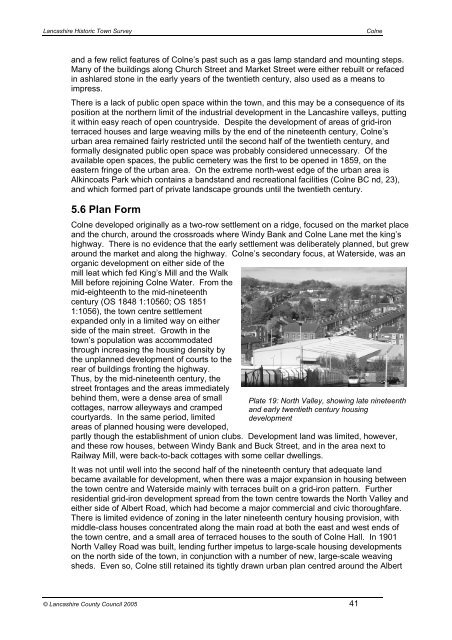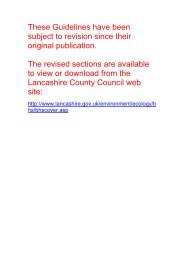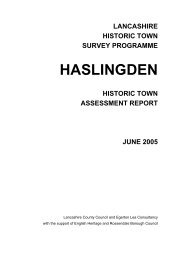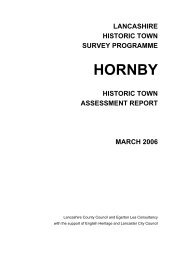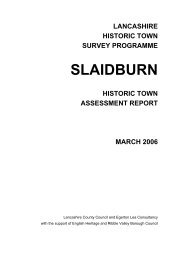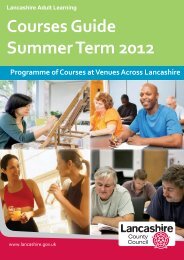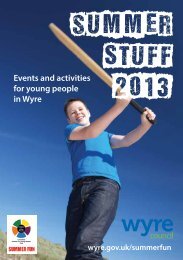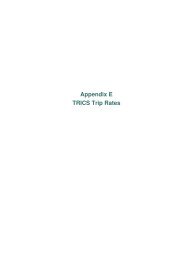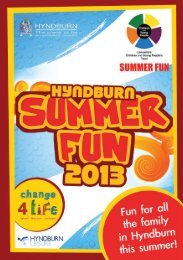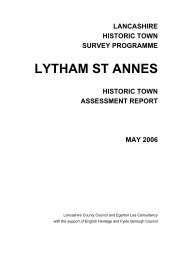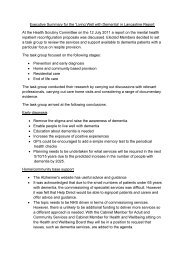Colne - Lancashire County Council
Colne - Lancashire County Council
Colne - Lancashire County Council
Create successful ePaper yourself
Turn your PDF publications into a flip-book with our unique Google optimized e-Paper software.
<strong>Lancashire</strong> Historic Town Survey<strong>Colne</strong>and a few relict features of <strong>Colne</strong>’s past such as a gas lamp standard and mounting steps.Many of the buildings along Church Street and Market Street were either rebuilt or refacedin ashlared stone in the early years of the twentieth century, also used as a means toimpress.There is a lack of public open space within the town, and this may be a consequence of itsposition at the northern limit of the industrial development in the <strong>Lancashire</strong> valleys, puttingit within easy reach of open countryside. Despite the development of areas of grid-ironterraced houses and large weaving mills by the end of the nineteenth century, <strong>Colne</strong>’surban area remained fairly restricted until the second half of the twentieth century, andformally designated public open space was probably considered unnecessary. Of theavailable open spaces, the public cemetery was the first to be opened in 1859, on theeastern fringe of the urban area. On the extreme north-west edge of the urban area isAlkincoats Park which contains a bandstand and recreational facilities (<strong>Colne</strong> BC nd, 23),and which formed part of private landscape grounds until the twentieth century.5.6 Plan Form<strong>Colne</strong> developed originally as a two-row settlement on a ridge, focused on the market placeand the church, around the crossroads where Windy Bank and <strong>Colne</strong> Lane met the king’shighway. There is no evidence that the early settlement was deliberately planned, but grewaround the market and along the highway. <strong>Colne</strong>’s secondary focus, at Waterside, was anorganic development on either side of themill leat which fed King’s Mill and the WalkMill before rejoining <strong>Colne</strong> Water. From themid-eighteenth to the mid-nineteenthcentury (OS 1848 1:10560; OS 18511:1056), the town centre settlementexpanded only in a limited way on eitherside of the main street. Growth in thetown’s population was accommodatedthrough increasing the housing density bythe unplanned development of courts to therear of buildings fronting the highway.Thus, by the mid-nineteenth century, thestreet frontages and the areas immediatelybehind them, were a dense area of smallcottages, narrow alleyways and crampedcourtyards. In the same period, limitedareas of planned housing were developed,Plate 19: North Valley, showing late nineteenthand early twentieth century housingdevelopmentpartly though the establishment of union clubs. Development land was limited, however,and these row houses, between Windy Bank and Buck Street, and in the area next toRailway Mill, were back-to-back cottages with some cellar dwellings.It was not until well into the second half of the nineteenth century that adequate landbecame available for development, when there was a major expansion in housing betweenthe town centre and Waterside mainly with terraces built on a grid-iron pattern. Furtherresidential grid-iron development spread from the town centre towards the North Valley andeither side of Albert Road, which had become a major commercial and civic thoroughfare.There is limited evidence of zoning in the later nineteenth century housing provision, withmiddle-class houses concentrated along the main road at both the east and west ends ofthe town centre, and a small area of terraced houses to the south of <strong>Colne</strong> Hall. In 1901North Valley Road was built, lending further impetus to large-scale housing developmentson the north side of the town, in conjunction with a number of new, large-scale weavingsheds. Even so, <strong>Colne</strong> still retained its tightly drawn urban plan centred around the Albert© <strong>Lancashire</strong> <strong>County</strong> <strong>Council</strong> 2005 41


